上海牛津英语6B课时教案6B U7 P1--P3 Travelling in Garden City
牛津上海版6b教案
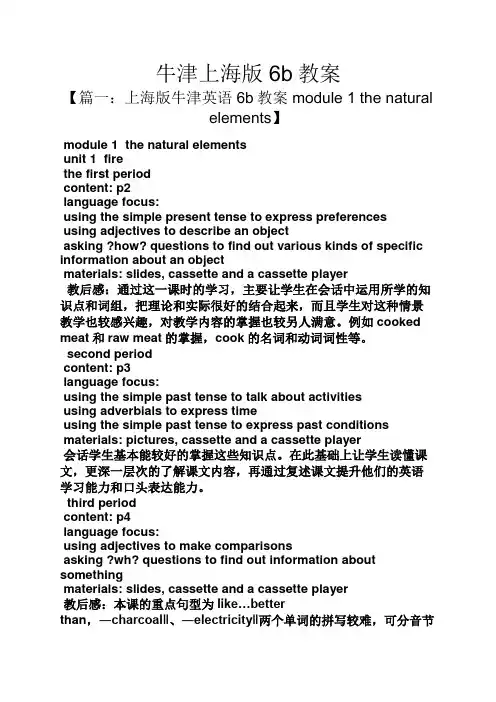
牛津上海版6b教案【篇一:上海版牛津英语6b教案 module 1 the naturalelements】module 1 the natural elementsunit 1 firethe first periodcontent: p2language focus:using the simple present tense to express preferencesusing adjectives to describe an objectasking ?how? questions to find out various kinds of specific information about an objectmaterials: slides, cassette and a cassette player教后感:通过这一课时的学习,主要让学生在会话中运用所学的知识点和词组,把理论和实际很好的结合起来,而且学生对这种情景教学也较感兴趣,对教学内容的掌握也较另人满意。
例如cooked meat和raw meat的掌握,cook的名词和动词词性等。
second periodcontent: p3language focus:using the simple past tense to talk about activitiesusing adverbials to express timeusing the simple past tense to express past conditionsmaterials: pictures, cassette and a cassette player会话学生基本能较好的掌握这些知识点。
在此基础上让学生读懂课文,更深一层次的了解课文内容,再通过复述课文提升他们的英语学习能力和口头表达能力。
third periodcontent: p4language focus:using adjectives to make comparisonsasking ?wh? questions to find out information about somethingmaterials: slides, cassette and a cassette player教后感:本课的重点句型为like…betterthan,―charcoal‖、―electricity‖两个单词的拼写较难,可分音节教学生拼写。
上海版牛津英语6b全册教案【推荐下载】
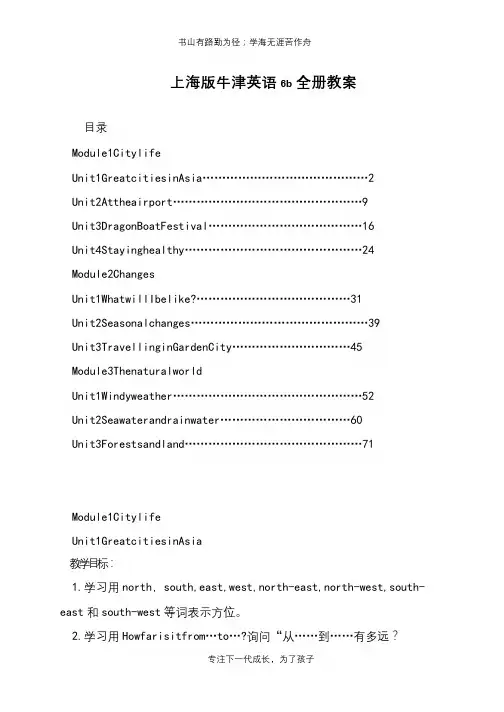
上海版牛津英语6b全册教案目录Module1CitylifeUnit1GreatcitiesinAsia (2)Unit2Attheairport (9)Unit3DragonBoatFestival (16)Unit4Stayinghealthy (24)Module2ChangesUnit1WhatwillIbelike? (31)Unit2Seasonalchanges (39)Unit3TravellinginGardenCity (45)Module3ThenaturalworldUnit1Windyweather (52)Unit2Seawaterandrainwater (60)Unit3Forestsandland (71)Module1CitylifeUnit1GreatcitiesinAsia教学目标:1.学习用north,south,east,west,north-east,north-west,south- east和south-west等词表示方位。
2.学习用Howfarisitfrom…to…?询问“从……到……有多远?3.复习用Howcanwetravelto…?询问“我们可以怎样去……?”以及用“介词by+交通工具”表示交通方式。
4.复习用Howlongdoesittaketotravelfrom…to…询问“从……到……要花多长时间?”5.学习用like/love/enjoydoing…表示“喜欢做……”。
教具准备:smallblackboardradio课时安排:四课时第一课时教学过程:Step1:Showthesubjectandtheaims.1.Greetings.2.Showthesubjectandtheaims.T:Boysandgirls,todaywe’regoingtolearnModule1CitylifeUnit1Greatc itiesinAsia(板书)Hereareouraims,theyare…(利用小黑板出示学习目标) Learnaims:1.学习本课的单词。
牛津英语上海版六年级下册6B Module 2 Unit 7 Travelling in Garden City 3课时教案附反思
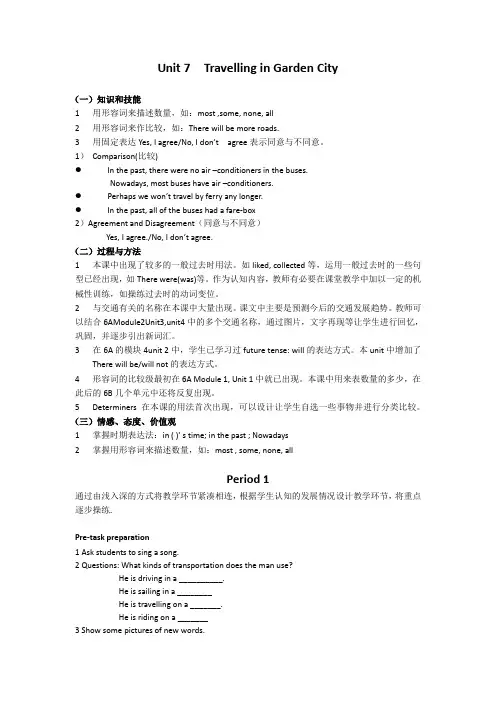
Unit 7 Travelling in Garden City(一)知识和技能1用形容词来描述数量,如:most ,some, none, all2用形容词来作比较,如:There will be more roads.3用固定表达Yes, I agree/No, I don’t agree表示同意与不同意。
1)Comparison(比较)●In the past, there were no air –conditioners in the buses.Nowadays, most buses have air –conditioners.●Perhaps we won’t travel by ferry any longer.●In the past, all of the buses had a fare-box2)Agreement and Disagreement(同意与不同意)Yes, I agree./No, I don’t agree.(二)过程与方法1 本课中出现了较多的一般过去时用法。
如liked, collected等,运用一般过去时的一些句型已经出现,如There were(was)等。
作为认知内容,教师有必要在课堂教学中加以一定的机械性训练,如操练过去时的动词变位。
2 与交通有关的名称在本课中大量出现。
课文中主要是预测今后的交通发展趋势。
教师可以结合6AModule2Unit3,unit4中的多个交通名称,通过图片,文字再现等让学生进行回忆,巩固,并逐步引出新词汇。
3 在6A的模块4unit 2中,学生已学习过future tense: will的表达方式。
本unit中增加了There will be/will not的表达方式。
4 形容词的比较级最初在6A Module 1, Unit 1中就已出现。
本课中用来表数量的多少,在此后的6B几个单元中还将反复出现。
5 Determiners在本课的用法首次出现,可以设计让学生自选一些事物并进行分类比较。
上海初中英语6B教案
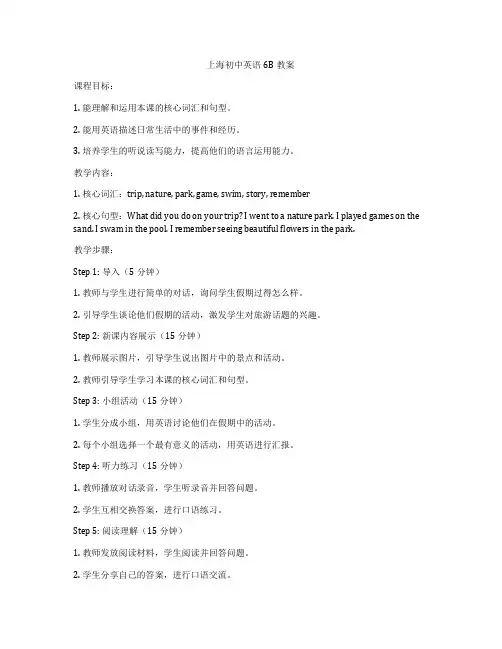
上海初中英语6B教案课程目标:1. 能理解和运用本课的核心词汇和句型。
2. 能用英语描述日常生活中的事件和经历。
3. 培养学生的听说读写能力,提高他们的语言运用能力。
教学内容:1. 核心词汇:trip, nature, park, game, swim, story, remember2. 核心句型:What did you do on your trip? I went to a nature park. I played games on the sand. I swam in the pool. I remember seeing beautiful flowers in the park.教学步骤:Step 1: 导入(5分钟)1. 教师与学生进行简单的对话,询问学生假期过得怎么样。
2. 引导学生谈论他们假期的活动,激发学生对旅游话题的兴趣。
Step 2: 新课内容展示(15分钟)1. 教师展示图片,引导学生说出图片中的景点和活动。
2. 教师引导学生学习本课的核心词汇和句型。
Step 3: 小组活动(15分钟)1. 学生分成小组,用英语讨论他们在假期中的活动。
2. 每个小组选择一个最有意义的活动,用英语进行汇报。
Step 4: 听力练习(15分钟)1. 教师播放对话录音,学生听录音并回答问题。
2. 学生互相交换答案,进行口语练习。
Step 5: 阅读理解(15分钟)1. 教师发放阅读材料,学生阅读并回答问题。
2. 学生分享自己的答案,进行口语交流。
Step 6: 写作练习(15分钟)1. 教师发放写作题目,学生按要求进行写作。
2. 学生互相交换作文,进行修改和评价。
Step 7: 总结与作业(5分钟)1. 教师对本节课的内容进行总结,强调重点词汇和句型。
2. 布置作业:用英语写一篇关于假期的作文。
教学评价:1. 课堂参与度:观察学生在课堂上的发言和互动情况,评价他们的参与度。
2. 语言运用能力:通过听力练习、口语交流和写作练习,评价学生的语言运用能力。
牛津上海版英语六年级下册Unit7TravellinginGardenCity单元分析以及教学设计
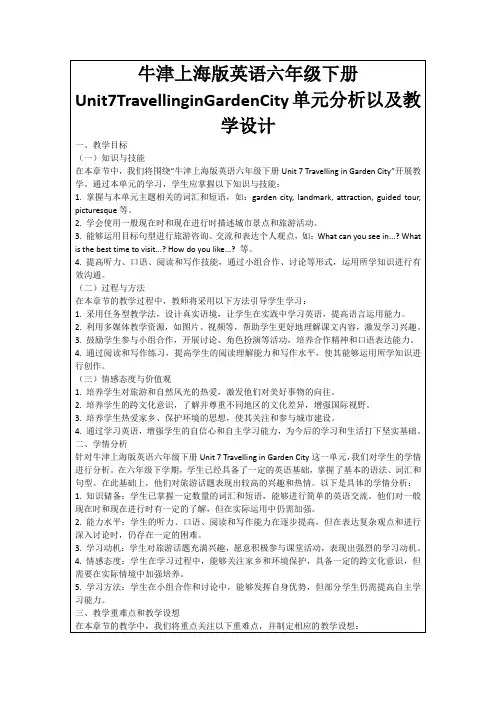
-阅读:阅读课文,完成相关练习,提高阅读分析能力。
-写作:编写一份旅游手册,运用所学词汇和句型,锻炼写作能力。
(五)总结归纳
1.教学活动:教师引导学生对本节课所学内容进行回顾和总结,巩固知识点。
2.教学方法:采用总结法、问答法,帮助学生梳理所学知识,提高记忆效果。
(二)过程与方法
在本章节的教学过程中,教师将采用以下方法引导学生学习:
1.采用任务型教学法,设计真实语境,让学生在实践中学习英语,提高语言运用能力。
2.利用多媒体教学资源,如图片、视频等,帮助学生更好地理解课文内容,激发学习兴趣。
3.鼓励学生参与小组合作,开展讨论、角色扮演等活动,培养合作精神和口语表达能力。
-语法:通过实例,讲解一般现在时和现在进行时的用法,并让学生进行实际操作。
-句型:学习目标句型,如What can you see in...? What is the best time to visit...?等,并进行情景对话练习。
(三)学生小组讨论
1.教学活动:将学生分成小组,让他们围绕本单元的主题展开讨论,分享自己的旅游经历或梦想之旅。
(二)教学设想
1.创设情境:通过多媒体展示世界各地花园城市的图片和视频,激发学生的学习兴趣,同时为学生提供真实的语言环境,促进他们对语法和词汇的吸收。
-设想活动:开展“我是小导游”的角色扮演活动,让学生在模拟情境中使用目标语言介绍景点。
2.互动交流:设计小组合作任务,如制作旅游手册、讨论最佳旅游时间等,鼓励学生之间的互动交流,提高口语表达能力。
-作业目的:增强学生的阅读理解能力,扩展他们的知识视野。
4.词汇作业:要求学生制作单词卡片,包括本单元学到的至少10个新词汇和短语。每张卡片上需要写上单词、词性、中文释义和例句。
精心整理上海牛津英语6B重点单词及词组讲课教案
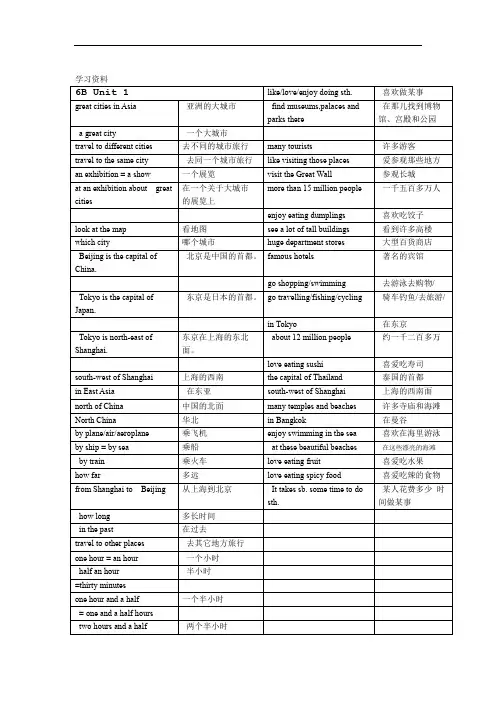
more than 15 million people
一千五百多万人
enjoy eating dumplings
喜欢吃饺子
look at the map
看地图
see a lot of tall buildings
看到许多高楼
which city
哪个城市
huge department stores
one hour and a half
一个半小时
= one and a half hours
two hours and a half
两个半小时
= two and a half hours
one day and a half
一天半
= one and a half days
two days and a half
出差
pack the suitcase
整理手提箱
a lot of signs
许多标记
enough room/ space
足够的空间
What does each sign mean?
每个标记什么意
the Space Museum
太空博物馆
思?
too many things
太多的东西
too much money
太多的钱
so many things
如此多的东西
so much money
如此多的钱
a flight trip
一次航班旅行
drive sb to sp
开车送某人去某地
leave for sp.=go to sp.
离开去某地
=depart for sp.
牛津英语6b全册教案
牛津英语6b全册教案Unit6Planningfrtheeeend一教学内容:1能听懂、会说和会读和会拼写单词:pini,plan,taepartin,pla2能听懂、会说和会读单词ntest,Beiingperash,singingntest,sprtseeting3能听懂、会说、会读和会写句型:hatareegingtd…?earegingt…二教学目标:1能听懂、会说和会读和会拼写单词:pini,plan,taepartin,pla2能听懂、会说和会读单词ntest,Beiingperash,singingntest,sprtseeting3能听懂、会说、会读和会写句型:hatareegingtd…?earegingt…三教学重点和难点:hatareegingtd…?earegingt…句型进行对话四前准备:录音机,挂图五教学过程教学环节教师活动学生活动AFreetal一、师生自由交流1、hihseasnduliebest?Ilie…h?Beauseit’s…Ian…2、Duliebasetball?es,IdIliebasetball,tI’gingtplabasetballthisafternnBPresentatin1呈现B小图片,haveapini师生通过对话区别现在进行时和一般将来时L,hataretheding?ThearehavingapiniDuliehavingapini?e s,Ide’regingthaveapinithisSunda教师讲解在进行时和一般将来时两者的区别或者就让学生说说两者有什么明显的区别2用以上方法教学前四副图3看图,师引导学生对话,学习giveapuppetshLatthispiturehatishegingtdthisevening? Heisgingtgiveapuppetsh4依照以上方法教学后四副图,同时要注意人称的变化引起be动词的变化nslidatin1看图完成部分的对话练习。
六年级:牛津英语6b全册教案
小学英语新课程标准教材英语教案( 2019 — 2020学年度第二学期 )学校:年级:任课教师:英语教案 / 小学英语 / 小学六年级英语教案编订:XX文讯教育机构牛津英语6b全册教案教材简介:本教材主要用途为通过学习英语的内容,提高学生的语言技能,增加一项语言能力,有利于国际化的日常交流、生活、工作等,本教学设计资料适用于小学六年级英语科目, 学习后学生能得到全面的发展和提高。
本内容是按照教材的内容进行的编写,可以放心修改调整或直接进行教学使用。
unit 6 planning for the weekend (第一教时)一教学内容:1能听懂、会说和会读和会拼写单词:picnic , plan ,take part in ,play2能听懂、会说和会读单词contest ,beijing opera show ,singing contest ,sports meeting 3能听懂、会说、会读和会写句型:what are we going to do …?we are going to …二教学目标:1能听懂、会说和会读和会拼写单词:picnic , plan ,take part in ,play2能听懂、会说和会读单词contest ,beijing opera show ,singing contest ,sports meeting 3能听懂、会说、会读和会写句型:what are we going to do …?we are going to …三教学重点和难点:what are we going to do …?we are going to …句型进行对话.四课前准备:录音机,挂图五教学过程教学环节教师活动学生活动a free talk一、师生自由交流. 1、which season do you like best ?i like … why ? because it’s … i can …2、do you like basketball ?yes , i do .i like basketball ,too . i’m going to play basketball this afternoon.b presentation1呈现b小图片,have a picnic 师生通过对话区别现在进行时和一般将来时.look ,what are they doing ?they are having a picnic .do you like having a picnic ?yes ,i do .we’re going to have a picnic this sunday .教师讲解在进行时和一般将来时两者的区别或者就让学生说说两者有什么明显的区别.2用以上方法教学前四副图.3看图,师引导学生对话,学习give a puppet show .look at this picture . what is he going to do this evening ?he is going to give a puppet show . 4.依照以上方法教学后四副图,同时要注意人称的变化引起be动词的变化.c consolidation1.看图完成c部分的对话练习。
牛津上海版英语六年级下册《Unit7TravellinginGardenCity》说课稿4
牛津上海版英语六年级下册《Unit 7 Travelling in Garden City》说课稿4一. 教材分析《Unit 7 Travelling in Garden City》是人教版牛津英语六年级下册的一单元,主要介绍了花园城市-新加坡的旅游景点。
通过本单元的学习,学生可以了解新加坡的自然风光、人文景观以及风土人情,提高学生学习英语的兴趣。
教材内容丰富,插图精美,激发了学生学习的兴趣。
二. 学情分析六年级的学生已经具备了一定的英语基础,对英语学习有较高的兴趣。
但部分学生在英语听说方面还存在一定的困难,因此,在教学过程中,需要关注这部分学生的学习需求,提高他们的英语听说能力。
此外,学生对新加坡的了解相对较少,因此,需要在教学中引导学生了解新加坡的相关背景知识。
三. 说教学目标1.知识目标:学生能够掌握有关新加坡旅游景点的词汇和表达方式,如:zoo, botanical garden,Merlion, etc.;能够运用所学的词汇和句型介绍新加坡的旅游景点。
2.能力目标:学生能够在图片或情景的帮助下,正确使用目标句型进行交流,提高学生的英语口语表达能力。
3.情感目标:通过介绍新加坡的旅游景点,激发学生对新加坡的兴趣,培养学生的跨文化交际意识。
四. 说教学重难点1.重点:学生能够掌握有关新加坡旅游景点的词汇和表达方式,能够运用所学的词汇和句型进行交流。
2.难点:学生能够正确运用目标句型介绍新加坡的旅游景点,并在实际情景中进行运用。
五. 说教学方法与手段1.交际法:通过情景模拟、角色扮演等方式,让学生在实际语境中运用所学知识进行交流。
2.情境教学法:利用图片、视频等教学资源,为学生创设生动、直观的学习情境,提高学生的学习兴趣。
3.任务型教学法:通过完成各种任务,让学生在实践中掌握所学知识,提高学生的实际应用能力。
4.多媒体教学手段:利用多媒体课件、网络资源等,丰富教学内容,提高学生的学习兴趣。
六. 说教学过程1.导入:以新加坡的风景图片或视频为导入,激发学生的学习兴趣,引导学生谈论关于新加坡的话题。
牛津沪教版六年级英语6BUnit1-3复习教案.docx
Ml Unitl-3巩固复习一、课前回顾单词默写:二、新课导入【句型万花筒】Unit 1 Great cities in Asia亚洲的著名城市Ask and answer 问一问,答一答S1: Which city is the capital of...?哪个城市是 ...... 的首都?S2: ... is the capital of...? ............. 是... 的首都。
SI: Where is it?它在哪里?S2: It's ... of Shanghai.它在上海的 ..... 。
Ask and answer 问一问,答一答How far is it from Shanghai to ...?从上海到.・・・・.有多远?City Beijing Tokyo Bangkok How far?1,4002,3003,050kilometres kilometres kilometres How long?/ 1 hour and 2 hour and4 hoursby plane50 minutes30 minutesHow long?/by ship/11.5 days15.5 days How long?/by train10 hours//SI : How far is it from Shanghai to ...?从上海到 ..... 有多远?S2: It's about...它大约 .....SI: How can wc travel to ...?我们怎样去...... ?S2: We can travel by ...我们可以坐..... 去。
S1: How long does it take to travel from ... to ... by ...?乘……从......到......要花费多少时间?S2: It takes about...大约花费.....Unit 2 At the airport在飞机场Ask and answer 问一问,答一答You are going to another country for a holiday. In pairs, look at the timetable and talk about it. 你们打算去另外一个国家度假。
- 1、下载文档前请自行甄别文档内容的完整性,平台不提供额外的编辑、内容补充、找答案等附加服务。
- 2、"仅部分预览"的文档,不可在线预览部分如存在完整性等问题,可反馈申请退款(可完整预览的文档不适用该条件!)。
- 3、如文档侵犯您的权益,请联系客服反馈,我们会尽快为您处理(人工客服工作时间:9:00-18:30)。
Module 2 Changes
Unit 7 Travelling in Garden City
Topic: What will travelling in Garden City be like in 10 years’ time
Teaching aids: Multi-media facilities
Period one
Teaching objectives:
By the end of the class, the students will be able to
1.To learn the new words about transportation
2.To learn how to ask wh-questions to find out specific information
Vocabulary and phrases:
1.一辆双层巴士 a double-decker bus 单层巴士single-decker buses
2.一个投币箱 a fare box
3.一辆空调车an air-conditioned bus
4.一张交通卡 a public transportation card
5.喜欢乘公共汽车旅行like travelling by bus
6.在过去in the past
7.所有的乘客all passengers
8.从售票员那买票buy tickets from a bus conductor
9.为某人买某物buy sth for sb /buy sb sth (buy – bought – bought)
10.向乘客收钱collect money from the passengers
11.现在nowadays
12.在许多车上on many buses
13.不必买票don’t need to/don’t have to/ needn’t buy tickets
14.把钱放进投币箱put money in the fare box
15.代替(而不是)做某事instead of doing sth
16.我乘飞机去北京而不是乘火车去的I travelled to Beijing by plane instead of by train 17.没有空调车no air-conditioned buses
18.大多数的学生most students/ most of the students
19.他们都(三者或三者以上) (反)他们都不all of them/ none of them
20.他们(两个)都(反)both of them/ neither of them
21.没有公共汽车司机是女的None of the bus drivers were women.
22.一些公交司机some bus drivers/ some of the bus drivers
23.仍旧是男的still men
24.大量的游客plenty of visitors
25.十年后花园城市的交通会怎么样? What will travelling in Garden City be like in ten years’ time
=in ten years? 26.也许没有人会乘轮渡旅行。
Perhaps none of them will travel by ferry.
27.可能交通堵塞将更少。
Perhaps there will be fewer traffic jams
28.可能有更多的地铁站。
Perhaps there will be more underground stations.
29.轻轨light rails
30.许多立交桥many / a lot of flyovers 一座人行桥 a footbridge
31.在停车场in the car parks 在人行道上on the pavement
32.做个海报make a poster
33.discuss them with your classmates.
discuss sth. with sb.= talk about sth. with sb
34.见一个魔术师meet a magician
35.选择一把蓝色的尺choose a blue ruler
Homework : Copy the new words and phrases.
本课反思:
Period Two
Teaching objectives:
By the end of the class, the students will be able to
1.To learn the reading about transportation
2.To learn how to ask wh-questions to find out specific information
Teaching the Text:
1.instead [ɪn'sted] adv. 代替,更换
If you cannot go, let me go instead. / I didn’t have a pen, so I used a pencil instead.
要表达“用A代替B”则要用词组instead of, 后面可以跟名词、代词或动名词等,如:
We’ll have tea in the garden instead of in the house.我们将改在花园里喝茶,而不是在屋里
If you cannot go, let me go instead of you.
We watched TV instead of seeing a film.
2.Passengers do not have to buy tickets from a bus conductor.
don’t have to=don’‘t need to = needn’t do
3.用于三者以上: some /most / all /none of , 用于两者之间:both/neither of .(图标见书P50)
All of them were men. 他们所有人都是男性。
(1)如果some /most / all所代表的是可数名词,那它们的谓语动词用复数形式;如果代表的是不可数名词,那它们的谓语动词用单数形式。
Most of the shops in this city are closed at the weekend.
Some of the food in the fridge goes bad.
(2)none用来代表的是可数名词时,如果谓语动词用单数形式,则后接的名词也要用单数,如果谓语动词用复数形式,则后接的名词也要用复数。
None of them was a double-decker bus.没有一辆公共汽车是双层车。
In the past,none of the bus drivers were women.过去,没有一个公交车驾驶员是女性。
(3)上述词条后如接人称代词时,需用宾格。
如:
All of us like the sweet food.
Homework: WB P43
本课反思:
Period Three
Teaching objectives:
By the end of the class, the students will be able to
1.To learn how to ask wh-questions to find out specific information
e.g What will travelling in Garden City be like in 10 years’ time?
2. To learn how to use the simple future tense to talk about future events
3. To learn how to use adjectives to make comparison
Teaching difficulty and focus:
1.To learn how to use the simple future tense to talk about future events
e.g Perhaps none of the people will travel by ferry.
2. To learn how to use adjectives to make comparison
e.g Perhaps there will be fewer traffic jams.
Teaching aids: ppt; SB; WB; cassettes。
